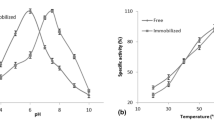Abstract
The current research examines the impact of agitation on deactivation of isoamylase and β-amylase under supercritical carbon dioxide (SC-CO2). Our experimental results showed that the activity of either enzyme decreased with increasing pressure or speed of agitation. The degree of enzymatic deactivation caused by pressure became more prominent in the presence of agitation, suggesting that the agitation plays an important role in enzymatic deactivation in SC-CO2 environment. Moreover, the enzymatic deactivation behavior associated with agitation and pressure was further quantitatively analyzed using a proposed inactivation kinetic model. Our analysis indicated that isoamylase and β-amylase exhibited significantly different relationships between the inverse of percentage residual activity and the product of number of revolution per time and time elapsed under pressurized carbon dioxide. We believe that the outcome from this work may provide a better understanding of the effects of agitation and pressure in enzyme deactivation behavior under SC-CO2.






Similar content being viewed by others
References
Canelas DA, DeSimone JM (1997) Polymerizations in liquid and supercritical carbon dioxide. Adv Polym Sci 133:103–140
Savage PE, Gopalan S, Mizan TI, Martino CJ, Brock EE (1995) Reactions at supercritical conditions—applications and fundamentals. AIChE J 41:1723–1778
Hu XB, Lesser AJ (2006) Solid-state processing of polymer in the presence of supercritical carbon dioxide. J Cell Plast 42:517–527
Nalawade SP, Picchioni F, Janssen LPBM (2006) Supercritical carbon dioxide as a green solvent for processing polymer melts: processing aspects and applications. Prog Polym Sci 31:19–43
Oliveira JV, Pinto JC, Dariva C (2005) Application of a modified RESS process for polypropylene microparticle production. Fluid Phase Equilib 228:381–388
Suttiruengwong S, Rolker J, Smirnova I, Arlt W, Seiler M, Luderitz L, de Diego YP, Jansens PJ (2006) Hyperbranched polymers as drug carriers: microencapsulation and release kinetics. Pharm Dev Technol 11:55–70
Mathieu LM, Mueller TL, Bourban PE, Pioletti DP, Muller R, Manson JAE (2006) Architecture and properties of anisotropic polymer composite scaffolds for bone tissue engineering. Biomaterials 27:905–916
Montjovent MO, Mathieu L, Hinz B, Applegate LL, Bourban PE, Zambelli PY, Manson JA, Pioletti DP (2005) Biocompatibility of bioresorbable poly(l-lactic acid) composite scaffolds obtained by supercritical gas foaming with human fetal bone cells. Tissue Eng 11:1640–1649
Reverchon E, Antonacci A (2006) Cyclodextrins micrometric powders obtained by supercritical fluid processing. Biotechnol Bioeng 94:753–761
Kirschning A, Solodenko W, Mennecke K (2006) Combining enabling techniques in organic synthesis: continuous flow processes with heterogenized catalysts. Chem Eur J 12:5972–5990
Nakamura K, Chi YM, Yamada Y, Yano T (1986) Lipase activity and stability in supercritical carbon dioxide. Chem Eng Commun 45:207
Randolph TW, Blanch HW, Prausnitz JM, Wilke CR (1985) Enzymatic catalysis in a supercritical fluid. Biotechnol Lett 7:325
Bauer C, Gamse T, Marr R (2001) Quality improvement of crude porcine pancreatic lipase preparations by treatment with humid supercritical carbon dioxide. Biochem Eng J 9:119–123
Tai CY, Huang SC, Huang MS, Liu HS (2001) Hydrolysis of amylopectin by isoamylase under supercritical carbon dioxide. J Chin Inst Chem Eng 32:269–275
Rezaei K, Temelli F, Jenab E (2007) Effects of pressure and temperature on enzymatic reactions in supercritical fluids. Biotechnol Adv 25:272–280
Liu HL, Hsieh WC, Liu HS (2004) Molecular dynamics simulations to determine the effect of supercritical carbon dioxide on the structural integrity of hen egg white lysozyme. Biotechnol Prog 20:930–938
Trzesniak D, Lins RD, van Gunsteren WF (2006) Protein under pressure: molecular dynamics simulation of the arc repressor. Proteins Struct Funct Bioinform 65:136–144
Paschek D, Gnanakaran S, Garcia AE (2005) Simulations of the pressure and temperature unfolding of an alpha-helical peptide. Proc Natl Acad Sci USA 102:6765–6770
Striolo A, Favaro A, Elvassore N, Bertucco A, Di Noto V (2003) Evidence of conformational changes for protein films exposed to high-pressure CO2 by FT-IR spectroscopy. J Supercrit Fluids 27:283–295
Allen WG, Dawson HG (1975) Technology and uses of debranching enzymes. Food Technol 29:70
Miyake H, Otsuka C, Nishimura S, Nitta Y (2002) Catalytic mechanism of beta-amylase from Bacillus cereus var. mycoides: chemical rescue of hydrolytic activity for a catalytic site mutant (Glu367→Ala) by azide. J Biochem 131:587–591
Wimmer Z, Zarevucka M (2010) A review on the effects of supercritical carbon dioxide on enzyme activity. Int J Mol Sci 11:233–253
Lee HS, Lee WG, Park SW, Lee H, Chang HN (1993) Starch hydrolysis using enzyme in supercritical carbon-dioxide. Biotechnol Tech 7:267–270
Harada T, Yokobayashi K, Misaki A (1968) Formation of isoamylase by Pseudomonas. Appl Microbiol 16:1439–1444
Bernfeld P (1955) Amylases alpha and beta. Methods Enzymol 1:149
Ganesh K, Joshi JB, Sawant SB (2000) Cellulase deactivation in a stirred reactor. Biochem Eng J 4:137–141
Mohanty M, Ghadge RS, Patil NS, Sawant SB, Joshi JB, Deshpande AV (2001) Deactivation of lipase at gas–liquid interface in stirred vessel. Chem Eng Sci 56:3401–3408
Ghadge RS, Sawant SB, Joshi JB (2003) Enzyme deactivation in a bubble column, a stirred vessel and an inclined plane. Chem Eng Sci 58:5125–5134
Hobbs HR, Thomas NR (2007) Biocatalysis in supercritical fluids, in fluorous solvents, and under solvent-free conditions. Chem Rev 107:2786–2820
Lencki RW, Tecante A, Choplin L (1993) Effect of shear on the inactivation kinetics of the enzyme dextransucrase. Biotechnol Bioeng 42:1061–1067
Lencki RW, Arul J, Neufeld RJ (1992) Effect of subunit dissociation, denaturation, aggregation, coagulation, and decomposition on enzyme inactivation kinetics. II. Biphasic and grace period behavior. Biotechnol Bioeng 40:1427–1434
Lencki RW, Arul J, Neufeld RJ (1992) Effect of subunit dissociation, denaturation, aggregation, coagulation, and decomposition on enzyme inactivation kinetics. I. First-order behaviour. Biotechnol Bioeng 40:1421–1426
Acknowledgments
This work was financially supported by the National Science Council, Taiwan.
Author information
Authors and Affiliations
Corresponding author
Rights and permissions
About this article
Cite this article
Wang, S.SS., Lai, JT., Huang, MS. et al. Deactivation of isoamylase and β-amylase in the agitated reactor under supercritical carbon dioxide. Bioprocess Biosyst Eng 33, 1007–1015 (2010). https://doi.org/10.1007/s00449-010-0425-7
Received:
Accepted:
Published:
Issue Date:
DOI: https://doi.org/10.1007/s00449-010-0425-7




